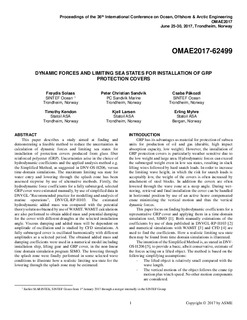| dc.contributor.author | Solaas, Frøydis | |
| dc.contributor.author | Sandvik, Peter Christian | |
| dc.contributor.author | Pakozdi, Csaba | |
| dc.contributor.author | Kendon, Timothy Edward | |
| dc.contributor.author | Larsen, kjell | |
| dc.contributor.author | Myhre, Erling | |
| dc.date.accessioned | 2017-11-29T07:41:21Z | |
| dc.date.available | 2017-11-29T07:41:21Z | |
| dc.date.created | 2017-11-28T08:39:02Z | |
| dc.date.issued | 2017-06-25 | |
| dc.identifier.citation | ASME 2017 36th International Conference on Ocean, Offshore and Arctic Engineering - Volume 9: Offshore Geotechnics; Torgeir Moan Honoring Symposium | nb_NO |
| dc.identifier.isbn | 978-0-7918-5777-9 | |
| dc.identifier.uri | http://hdl.handle.net/11250/2468316 | |
| dc.description.abstract | This paper describes a study aimed at finding and demonstrating a feasible method to reduce the uncertainties in calculation of dynamic forces and limiting sea states for installation of protection covers produced from glass fiber reinforced polyester (GRP). Uncertainties arise in the choice of hydrodynamic coefficients and the applied analysis method e.g. the Simplified Method, as suggested in DNV-OS-H206, versus time-domain simulations. The maximum limiting sea state for water entry and lowering through the splash zone has been assessed stepwise by use of alternative methods. Firstly, the hydrodynamic force coefficients for a fully submerged, selected GRP cover were estimated manually, by use of simplified data in DNVGL-“Recommended practice for modelling and analysis of marine operations”, DNVGL-RP-H103. The estimated hydrodynamic added mass was compared with the potential theory solution obtained by use of WAMIT. WAMIT calculations are also performed to obtain added mass and potential damping for the cover with different draughts at the selected installation angle. Viscous damping and added mass will be dependent on amplitude of oscillation and is studied by CFD simulations. A fully submerged cover is oscillated harmonically with different amplitudes at a selected period. The obtained added mass and damping coefficients were used in a numerical model including installation ship, lifting gear and GRP cover, in the non-linear time domain simulation program SIMO. The lowering through the splash zone were finally performed in some selected wave conditions to illustrate how a realistic limiting sea-state for the lowering through the splash zone may be estimated. | nb_NO |
| dc.language.iso | eng | nb_NO |
| dc.publisher | ASME Digital collection | nb_NO |
| dc.relation.ispartof | ASME 2017 36th International Conference on Ocean, Offshore and Arctic Engineering - Volume 9: Offshore Geotechnics; Torgeir Moan Honoring Symposium | |
| dc.relation.ispartofseries | ASME Proceedings | Torgeir Moan Honoring Symposium;OMAE2017-62499 | |
| dc.rights | Navngivelse-Ikkekommersiell-DelPåSammeVilkår 4.0 Internasjonal | * |
| dc.rights.uri | http://creativecommons.org/licenses/by-nc-sa/4.0/deed.no | * |
| dc.subject | Seas | nb_NO |
| dc.title | Dynamic Forces and Limiting Sea States for Installation of GRP Protection Covers | nb_NO |
| dc.type | Chapter | nb_NO |
| dc.description.version | acceptedVersion | nb_NO |
| dc.rights.holder | The authors | nb_NO |
| dc.identifier.doi | 10.1115/OMAE2017-62499 | |
| dc.identifier.cristin | 1519269 | |
| dc.relation.project | Norges forskningsråd: 237929 | nb_NO |
| cristin.unitcode | 7566,8,0,0 | |
| cristin.unitcode | 7566,9,0,0 | |
| cristin.unitname | Ocean Engineering | |
| cristin.unitname | Hydrodynamikk | |
| cristin.ispublished | true | |
| cristin.fulltext | postprint | |
| cristin.qualitycode | 1 | |

